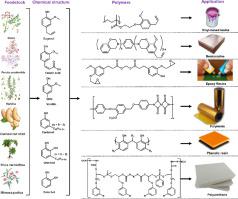Progress in Polymer Science ( IF 26.0 ) Pub Date : 2021-11-05 , DOI: 10.1016/j.progpolymsci.2021.101473 Chaoqun Zhang 1, 2 , Junqi Xue 1, 2 , Xiangyu Yang 1, 2 , Yanzi Ke 1, 2 , Rongxian Ou 1, 2 , Yang Wang 1, 2 , Samy A. Madbouly 3, 4 , Qingwen Wang 1, 2

|
Replacing petroleum-based products with inexpensive, biorenewable, natural materials is important for sustainable development and will have a significant impact on the polymer industry and the environment. Biorenewable aliphatic and cycloaliphatic compounds are less competitive with counterparts with aromatic structures for advanced polymeric materials in terms of rigidity, hydrophobicity, as well as chemical and thermal stability. Biorenewable plant phenols represent a diverse class of chemicals with a great industrial significance due to their unique structures and high abundance. The depolymerization process of lignin into small bio-based phenols is a relatively new approach and has received a considerable attention recently. This process produces key intermediates, phenolic compounds that can be used to develop and design wide range of high performance biorenewable multifunctional polymers and composites. In this review article, the production of biorenewable phenols from natural sources such as lignin by energy-, catalytic-, enzymatic-assisted depolymerization processes will be summarized. The different chemical modifications and polymerization pathways to obtain bio-based polymers (e.g. vinyl ester resins, cyanate ester, epoxy, benzoxazine resins, etc.) will be discussed. In addition, this review article will conclude with an overview of current and potential future applications of the bio-sourced phenolic-based materials in a wide range of automotive, electrical, and medical applications. Overall, the present review article will provide a quantitative experimental basis for the depolymerization process of lignin to produce biorenewable multifunctional phenolic-based polymers to increase our level of understanding of the behavior of this important class of polymeric materials and other similar bio-based polymers.
中文翻译:

从植物酚到新型生物基聚合物
用廉价的、生物可再生的天然材料代替石油基产品对于可持续发展很重要,并将对聚合物工业和环境产生重大影响。在刚性、疏水性以及化学和热稳定性方面,生物可再生脂肪族和脂环族化合物与具有芳族结构的高级聚合物材料的对应物相比没有竞争力。生物可再生植物酚类化合物由于其独特的结构和高丰度,代表了具有重要工业意义的多种化学品。木质素解聚成小分子生物基酚类的过程是一种相对较新的方法,最近受到了相当多的关注。该过程产生关键中间体,可用于开发和设计各种高性能生物可再生多功能聚合物和复合材料的酚类化合物。在这篇综述文章中,将总结通过能源、催化、酶促辅助解聚过程从木质素等天然来源生产生物可再生酚。将讨论获得生物基聚合物(例如乙烯基酯树脂、氰酸酯、环氧树脂、苯并恶嗪树脂等)的不同化学改性和聚合途径。此外,这篇评论文章将概述生物源酚醛基材料在广泛的汽车、电气和医疗应用中的当前和潜在的未来应用。总体,











































 京公网安备 11010802027423号
京公网安备 11010802027423号